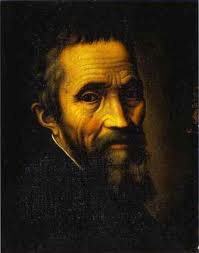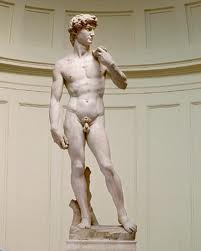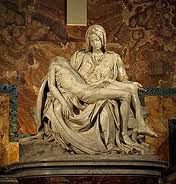Michelangelo

His full name was Michelangelo di Lodovico Buonarroti Simoni. He was born on March 6th, 1475 in Caprese, Italy. He was the second of five sons. A few weeks later he and his family moved to Florence . He showed a gift for art at a young age. Much to the dismay of his father he had no interest in school and spent his days at churches watching the painters. When he was 13 he was apprenticed to the workshop of painter Domenico Ghirlandaio, where he learned the technique of painting frescos.
A year later extraordinary opportunity arose. With the recommendation of Ghirlandaio, he moved into the house of Lorenzo de Medici to study classical sculpture in the Medici gardens. He spent 1489 to 1492 with the Medici’s. During this time he had had access to the social elite of Florence, which gave him the opportunity to study under the respected sculptor Bertoldo di Giovanni, and allowed him to be exposed to poets, scholars and Humanists. He also received special permission from the Catholic Church to dissect cadavers to get a better understanding of anatomy to better his art.
By the time he was 16 he had already developed his own artistic style and produced at least two relief sculptures, the Battle of the Centaurs and the Madonna of the Stairs, in his original beautiful yet realistic style. After Lorenzo’s death in 1492 the Medici’s and all their supporters were exiled from Florence. Since Michelangelo had spent a few years living with them he had to flee to Bologna. During this time he made several marble statuettes for the Arca Shrine di San Domenico in the Church of San Domenico.
In 1496 he moved to Rome and carved his first major statutes the Bacchus and the St Peter's Pietà. The Pietá is one of Michelangelo’s most famous statues. It depicted Mary holding Jesus’ dead body. It is the perfect mathematical sculptor because of the use of the pyramidal shape. Mary’s face shows complex emotions that keep people guessing what she is feeling. The realism of the way clothes fall add to the beauty of the sculpture. When The Pietá was revealed people thought that another sculptor had sculpted is. Michelangelo wanted to people to know that he created it, so he carved his name on a sash that goes across mary’s body.
He returned to Florence in 1501 as a famous sculptor. He took on many different projects, the largest of these being the David. The David was made of of a 17 foot piece of marble that two previous sculptors had attempted and failed to sculpt. It was originally meant to go on top of a church, but after its completion the church officials determined it was too good to go on top of the church where no one could see it. It showed great mathematical accomplishment, and it was also a symbol human freedom and Florence’s power over Rome.
Michelangelo considered himself a sculptor and did not like painting. He was upset when Pope Julius II commissioned him to paint the ceiling of the sistine chapel. He believed that he was chosen to paint the ceiling because it would stop him from using his true talent as a sculptor as punishment for not siding with the Medici’s. It was impossible to refuse the Pope so he began work on 40 by 13 meter fresco, depicting scenes from the bible, in 1508.
He hated every minute of the four years he worked on it. He was very temperamental and hard to work with. He often fired his assistants over minute details. He finished the ceiling in 1512, and the Pope liked it so much that he was commissioned to paint the altar wall of the chapel in 1537. Michelangelo finished painting the Last Judgement on the altar wall in 1541. There was a lot controversy surrounding fresco. People thought that the nude figures were inappropriate for a church. He also painted himself and others in the painting.
He died February 18, 1564. He only considered himself a sculptor, but he was an amazing painter along with a phenomenal sculptor. He showed the characteristics of a Renaissance man. He embraced his personal achievement and strived for perfection. He mixed realism with whimsical and created a unique style that people today still study and try to copy. He is considered to be the best artist of all time.
A year later extraordinary opportunity arose. With the recommendation of Ghirlandaio, he moved into the house of Lorenzo de Medici to study classical sculpture in the Medici gardens. He spent 1489 to 1492 with the Medici’s. During this time he had had access to the social elite of Florence, which gave him the opportunity to study under the respected sculptor Bertoldo di Giovanni, and allowed him to be exposed to poets, scholars and Humanists. He also received special permission from the Catholic Church to dissect cadavers to get a better understanding of anatomy to better his art.
By the time he was 16 he had already developed his own artistic style and produced at least two relief sculptures, the Battle of the Centaurs and the Madonna of the Stairs, in his original beautiful yet realistic style. After Lorenzo’s death in 1492 the Medici’s and all their supporters were exiled from Florence. Since Michelangelo had spent a few years living with them he had to flee to Bologna. During this time he made several marble statuettes for the Arca Shrine di San Domenico in the Church of San Domenico.
In 1496 he moved to Rome and carved his first major statutes the Bacchus and the St Peter's Pietà. The Pietá is one of Michelangelo’s most famous statues. It depicted Mary holding Jesus’ dead body. It is the perfect mathematical sculptor because of the use of the pyramidal shape. Mary’s face shows complex emotions that keep people guessing what she is feeling. The realism of the way clothes fall add to the beauty of the sculpture. When The Pietá was revealed people thought that another sculptor had sculpted is. Michelangelo wanted to people to know that he created it, so he carved his name on a sash that goes across mary’s body.
He returned to Florence in 1501 as a famous sculptor. He took on many different projects, the largest of these being the David. The David was made of of a 17 foot piece of marble that two previous sculptors had attempted and failed to sculpt. It was originally meant to go on top of a church, but after its completion the church officials determined it was too good to go on top of the church where no one could see it. It showed great mathematical accomplishment, and it was also a symbol human freedom and Florence’s power over Rome.
Michelangelo considered himself a sculptor and did not like painting. He was upset when Pope Julius II commissioned him to paint the ceiling of the sistine chapel. He believed that he was chosen to paint the ceiling because it would stop him from using his true talent as a sculptor as punishment for not siding with the Medici’s. It was impossible to refuse the Pope so he began work on 40 by 13 meter fresco, depicting scenes from the bible, in 1508.
He hated every minute of the four years he worked on it. He was very temperamental and hard to work with. He often fired his assistants over minute details. He finished the ceiling in 1512, and the Pope liked it so much that he was commissioned to paint the altar wall of the chapel in 1537. Michelangelo finished painting the Last Judgement on the altar wall in 1541. There was a lot controversy surrounding fresco. People thought that the nude figures were inappropriate for a church. He also painted himself and others in the painting.
He died February 18, 1564. He only considered himself a sculptor, but he was an amazing painter along with a phenomenal sculptor. He showed the characteristics of a Renaissance man. He embraced his personal achievement and strived for perfection. He mixed realism with whimsical and created a unique style that people today still study and try to copy. He is considered to be the best artist of all time.


